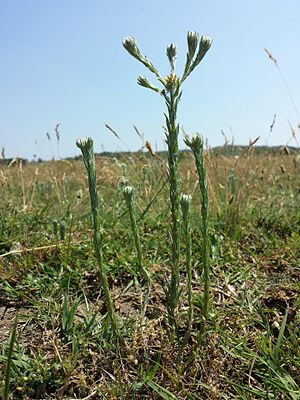German felt herb
| German felt herb | ||||||||||||
|---|---|---|---|---|---|---|---|---|---|---|---|---|

German feltwort ( Filago germanica ) |
||||||||||||
| Systematics | ||||||||||||
|
||||||||||||
| Scientific name | ||||||||||||
| Filago germanica | ||||||||||||
| ( L. ) Huds. |
The German cudweed ( Filago germanica ), also common-cudweed is a plant from the genus of Filzkräuter ( Filago ) in the family of Compositae (Asteraceae).
description
Vegetative characteristics
The German felt herb grows as a deciduous, annual herbaceous plant and reaches heights of 10 to 40 centimeters. The above-ground parts of the plant are gray-white, woolly-tomentose hair . The leaves are linear-lanceolate with a width of 1 to 3 millimeters and often wavy at their edge.
Generative characteristics
The flowering period extends from July to September. It forms clusters of 20 to 40 cup-shaped inflorescences that are not surmounted by the leaves . The inner bracts have a pink spot in the shape of a half moon in the middle. The middle bracts have an arched back and are almost bare.
The number of chromosomes is 2n = 28.
ecology
The German feltwort is a mesomorphic, scleromorphic therophyte .
There is pollination by insects and self-pollination .
There is Velcro spread and spread by wind and ants .
Occurrence
The German felt herb is common in Europe and Western Asia. It is a meridional , temperate and oceanic floral element .
In Germany , feltwort is endangered and rarely occurs in Baden-Württemberg , Hesse , Mecklenburg-Western Pomerania , Lower Saxony , North Rhine-Westphalia , Saxony-Anhalt and Schleswig-Holstein .
In Austria, the common felt herb occurs very rarely in the federal states of Vienna , Lower Austria , Burgenland , Styria and Tyrol in the colline altitude range . It is considered to be critically endangered. It is already extinct in Upper Austria and Carinthia .
The German Cudweed grows in sandy dry grassland on dry, sandy-gravelly Ruderalstellen , extensively used arable land and wasteland . In Central Europe it is a type of character of the Filagini-Vulpietum from the Thero-Airion association, but also occurs in societies of the Aperion and Caucalidion associations. In southern Europe it is a species of the order Thero-Brachypodietalia.
Taxonomy
The basionym Gnaphalium germanicum was first published in 1753 by Carl von Linné . William Hudson placed it in the genus Filago in 1762 . An important synonym of the valid published scientific name Filago germanica ( L. ) Huds. is Filago vulgaris Lam. It was proposed to preserve this name in 2011, which was rejected by the Vascular Plants Nomenclature Committee in 2012. Further synonyms are Filago canescens Jord. , Filago numidica Pomel , Filago subspicata Boreau and Gifola germanica Dumort.
Common names
The other German-language common names exist or existed for the German felt herb : Engelblümchen ( Silesia ), Angel flowers ( Thuringia ), Field cats (Silesia), Hinschkraut, Kätzlin (Silesia), Ruhrkraut and Schimmelkraut (Silesia).
literature
- Rudolf Schubert, Walter Vent (ed.): Excursion flora for the areas of the GDR and the FRG. Founded by Werner Rothmaler; with the collaboration of Manfred Bäßler. 5th edition. Volume 4: Critical Volume, People and Knowledge, Berlin 1982, p. 550.
Individual evidence
- ↑ a b c d e f Filago germanica (L.) Huds., Deutsches Filzkraut. In: FloraWeb.de.
- ^ A b Manfred A. Fischer, Karl Oswald, Wolfgang Adler: Excursion flora for Austria, Liechtenstein and South Tyrol . 3rd, improved edition. Province of Upper Austria, Biology Center of the Upper Austrian State Museums, Linz 2008, ISBN 978-3-85474-187-9 , p. 894 .
- ↑ a b Erich Oberdorfer : Plant-sociological excursion flora for Germany and neighboring areas . With the collaboration of Angelika Schwabe and Theo Müller. 8th, heavily revised and expanded edition. Eugen Ulmer, Stuttgart (Hohenheim) 2001, ISBN 3-8001-3131-5 , pp. 916 .
- ↑ Carl von Linné: Species Plantarum. Volume 2, Lars Salvius, Stockholm 1753, p. 857 ( digitized version ).
- ^ William Hudson: Flora Anglica. Self-published, London 1762, p. 3284, preview in Google book search.
- ↑ Santiago Andrés Sánchez; Mercé Galbany-Casals; Enrique Rico; Montserrat M. Martínez-Ortega: (2009) Proposal to conserve the name Filago vulgaris against Gnaphalium germanicum (Filago germanica) (Asteraceae). In: Taxon. Volume 60, No. 2, 2011, pp. 600–602 (online) ( page no longer available , search in web archives ) Info: The link was automatically marked as defective. Please check the link according to the instructions and then remove this notice. .
- ↑ Wendy Applequist: Report of the Nomenclature Committee for Vascular Plants: 64. In: Taxon. Volume 61, No. 5, 2012, pp. 1108–1117 (online; here: p. 1112) .
- ↑ Filago vulgaris at Tropicos.org. Missouri Botanical Garden, St. Louis, accessed October 29, 2015.
- ^ Georg August Pritzel , Carl Jessen : The German folk names of plants. New contribution to the German linguistic treasure. Philipp Cohen, Hannover 1882, p. 152 ( online ).
Web links
- Filago germanica L. Huds., German Filzkraut. In: FloraWeb.de.
- Filago germanica agg., Species group Deutsches Filzkraut. In: FloraWeb.de.
- German felt herb . In: BiolFlor, the database of biological-ecological characteristics of the flora of Germany.
- Profile and distribution map for Bavaria . In: Botanical Information Hub of Bavaria .
- Deutsches Filzkraut In: Info Flora , the national data and information center for Swiss flora .
- Thomas Meyer: Filzkraut data sheet with identification key and photos at Flora-de: Flora von Deutschland (old name of the website: Flowers in Swabia ).
- Data sheet with photos of common feltwort - Filago vulgaris at Botanik im Bild / Flora von Österreich , 2007.
- Data sheet with photo and distribution in France at Tela Botanica .


